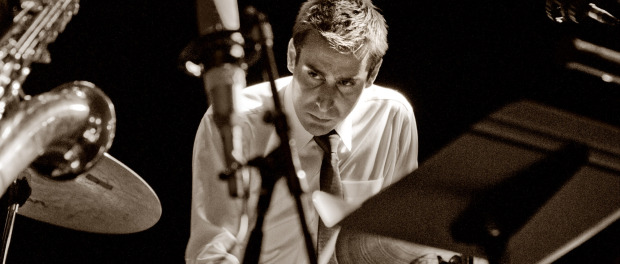Jim Doxas Show Review: Taking the Leap to Release Blind Leap
For some reason, the concept of modern jazz carries with it certain negative connotations – a certain air of pretension, perhaps of snobbishness. Say the words “avant-garde” or “experimental” in conjunction with jazz and just watch the looks you’ll get. In any case, I was treated to more than one of them when I used a couple of these words to describe the Jim Doxas Trio and their first concert, the release of Blind Leap.
The show certainly did start off in a less than traditional way. The concert venue l’Astral was plunged in darkness, and three solitary spotlights lit the stage for bassist Morgan Moore, pianist Paul Shrofel, and drummer Jim Doxas. Along with this unusual setting came strange sounds growing in intensity, mainly from the drums – the rim of the cymbals, the beating of toms with hands, a chain of bells around the drummer’s torso, and even the scrunching of paper contributed to the atmospheric buildup occurring onstage. Moore began to play low notes on his bass, and eventually Shrofel joined with eery, disjointed fragments on the highest register of the piano. Having set the sonic landscape, we received the first chord with relief, and the first actual beat that, after a few minutes, had us smiling and tapping our feet with enthusiasm.
And so the concert had begun, though it still felt far from being typical. The first pieces did not seem to follow a standard jazz form, and no program or explanations between each tune served as indication of what was being played. Instead, moods were presented to us almost as a series of connected tableaux – atmospheric sound became rousing swing and then was suddenly a cool, laid-back groove. The audience listened attentively, not clapping in the middle of songs as jazz audiences generally do – that is, until the first clearly recognizable bass solo about half an hour in, where Moore’s talent truly came to light in an impressively fast-paced display of virtuosity.
Throughout the evening, the trio often maintained eye contact, listening attentively to each others’ improvisations, frequently grinning and even laughing in glee as they listened to their fellow band mates.
In fact, this interaction between the trio became a crucial theme that night. Already a necessary component of jazz, it was particularly strong in the musical exchanges of the Jim Doxas trio. Often, not one person was soloing nor playing the melody in particular; rather, the instrumentalists responded to their band mates, weaving themselves around the harmonies of the others. This was as true for the drums as the other instruments. Jim Doxas doesn’t seem to play drums in the traditional way, by simply keeping a steady and consistent beat throughout. Instead, he fully explores the sounds of his instrument, making his cymbals sing with unusual techniques, switching between brushes, mallets and hands to make melodic phrases in much the same way a bass or piano would.
The listening of the Jim Doxas Trio concert felt somewhat like spying on a lively conversation between good friends. The way that their melodic lines bounced off of one another made it clear that their musical relationship goes far back, and their interaction throughout contributed to the spontaneity and the excitement of their tunes.
I suppose that’s why, when thinking back on the concert, I was not struck by any sign of snobbery. The music that might otherwise be viewed as pretentious (playing the drums with paper? Really?) was approached by the Jim Doxas trio with the endearing enthusiasm of children hard at play. In other words, these guys were having a hell of a lot of fun. So how could we not enjoy it?






